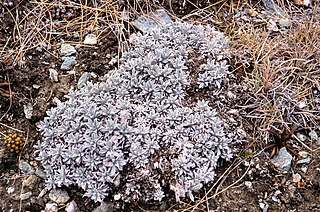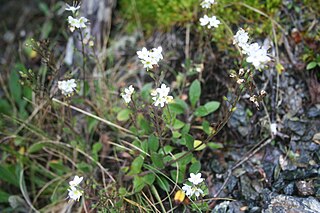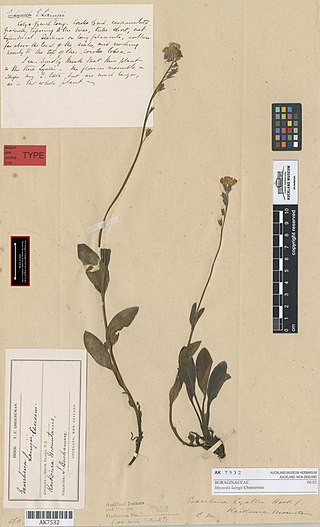
Myosotis monroi is a species of flowering plant in the family Boraginaceae endemic to the South Island of New Zealand. The species was described by Thomas Cheeseman. Plants of this species of forget-me-not are perennial and erect, and have ebracteate inflorescences with cream or white corollas.

Myosotis albosericea is a species of flowering plant in the family Boraginaceae, endemic to the South Island of New Zealand. Joseph Dalton Hooker described the species in 1867. Plants of this species of forget-me-not are perennial rosettes which form loose clumps, with ebracteate, erect inflorescences, and yellow corollas.

Myosotis concinna is a species of flowering plant in the family Boraginaceae, endemic to the South Island of New Zealand. Thomas Cheeseman described the species in 1885. Plants of this species of forget-me-not are large, perennial rosettes which form loose tufts or clumps, with ebracteate, erect inflorescences, and yellow corollas.

Myosotis laeta is a species of flowering plant in the family Boraginaceae, endemic to ultramafic areas of the Sounds-Nelson area of the South Island of New Zealand. Thomas Cheeseman described the species in 1885. Plants of this species of forget-me-not are perennial rosettes which form loose tufts or clumps, with ebracteate, erect inflorescences, and white corollas.

Myosotis brockiei is a species of flowering plant in the family Boraginaceae, endemic to southern South Island of New Zealand. Lucy Moore and Margaret Simpson described the species in 1973. Plants of this species of forget-me-not are perennial rosettes which form loose tufts or clumps, with ebracteate, erect inflorescences, and white corollas with exserted stamens.
Myosotis brockieisubsp. dysis is a subspecies of flowering plant in the family Boraginaceae, endemic to southern South Island of New Zealand. Shannel Courtney and Heidi Meudt described this subspecies in 2021. Plants of this subspecies of forget-me-not are perennial rosettes which form stoloniferous mats, with long, ebracteate, erect inflorescences, and white corollas with exserted stamens.

Myosotis goyenii is a species of flowering plant in the family Boraginaceae, endemic to the South Island of New Zealand. Donald Petrie described the species in 1891. Plants of this species of forget-me-not are perennial rosettes which form loose tufts or clumps, with ebracteate, erect inflorescences, and white corollas with partly exserted or fully included stamens.

Myosotis traversii is a species of flowering plant in the family Boraginaceae, endemic to the South Island of New Zealand. Joseph Dalton Hooker described this species in 1864. Plants of this species of forget-me-not are perennial rosettes which form tufts or clumps, with ebracteate, erect inflorescences, and white or yellow corollas with partly exserted stamens.

Myosotis traversiisubsp. traversii is a subspecies of flowering plant in the family Boraginaceae, endemic to the northern South Island of New Zealand. Joseph Dalton Hooker described the species M. traversii in 1864. Plants of this subspecies of forget-me-not are perennial rosettes which form tufts or clumps, with ebracteate, erect inflorescences, and white or yellow corollas with partly exserted stamens.

Myosotis traversiisubsp. cantabrica is a subspecies of flowering plant in the family Boraginaceae, endemic to the central South Island of New Zealand. Lucy Moore described M. traversii var. cantabrica in 1961 and Heidi Meudt changed its rank to subspecies in 2021. Plants of this subspecies of forget-me-not are perennial rosettes which form tufts or clumps, with ebracteate, erect inflorescences, and white or yellow corollas with partly exserted stamens.
Myosotis × cinerascens is a hybrid species of flowering plant in the family Boraginaceae, endemic to the South Island of New Zealand. Donald Petrie described M. cinerascens in 1891, and it was later deemed to be a hybrid in 2021. Plants of this forget-me-not are perennial rosettes which form tufts or clumps, with ebracteate, erect inflorescences, and white corollas with partly exserted stamens.

Myosotis australis is a species of flowering plant in the family Boraginaceae, native to New Zealand, Australia and New Guinea. Robert Brown described this species in 1810. Plants of this species of forget-me-not are perennial rosettes with ebracteate inflorescences and white or yellow corollas with stamens that are fully included in the corolla tube or sometimes partly protruded.

Myosotis australissubsp. australis is a subspecies of flowering plant in the family Boraginaceae, native to New Zealand and Australia. Robert Brown described M. australis in 1810. Plants of this subspecies of forget-me-not are perennial rosettes with ebracteate inflorescences and white or yellow corollas with stamens that are fully included in the corolla tube or sometimes partly protruded.

Myosotis angustata is a species of flowering plant in the family Boraginaceae, endemic to the South Island of New Zealand. Thomas Cheeseman described the species in 1906. Plants of this species of forget-me-not are perennial rosettes with ebracteate inflorescences and white corollas with stamens that are wholly exserted.

Myosotis saxosa is a species of flowering plant in the family Boraginaceae, endemic to the North Island of New Zealand. Joseph Dalton Hooker described the species in 1853. Plants of this species of forget-me-not are perennial rosettes with ebracteate inflorescences and white corollas with stamens that are exserted.

Myosotis macrantha is a species of flowering plant in the family Boraginaceae, endemic to the South Island of New Zealand. Joseph Dalton Hooker described the species as Exarrhena macrantha in 1864, and Thomas Cheeseman transferred it to the genus Myosotis in 1885. Plants of this species of forget-me-not are perennial rosettes with ebracteate inflorescences and yellow to dark purple corollas with stamens that are exserted.

Myosotis explanata is a species of flowering plant in the family Boraginaceae, endemic to high-elevation habitats in the South Island of New Zealand. Thomas Cheeseman described the species in 1906. Plants of this species of forget-me-not are perennial rosettes with ebracteate inflorescences and white corollas with stamens that are partly exserted, with the tips of the anthers only surpassing the scales.

Myosotis laingii is a species of flowering plant in the family Boraginaceae, endemic to the South Island of New Zealand, and considered to be extinct. Thomas Cheeseman described the species in 1912. Plants of this species of forget-me-not are perennial rosettes with ebracteate inflorescences and yellow corollas with stamens that are fully exserted.

Myosotis suavis is a species of flowering plant in the family Boraginaceae, endemic to the South Island of New Zealand. Donald Petrie described the species in 1914. Plants of this species of forget-me-not are perennial rosettes with ebracteate inflorescences and white corollas with stamens that are partially exserted.

Myosotis oreophila is a species of flowering plant in the family Boraginaceae, endemic to the South Island of New Zealand. Donald Petrie described the species in 1896. Plants of this species of forget-me-not are perennial rosettes with ebracteate inflorescences and white corollas with stamens that are partially exserted.


















